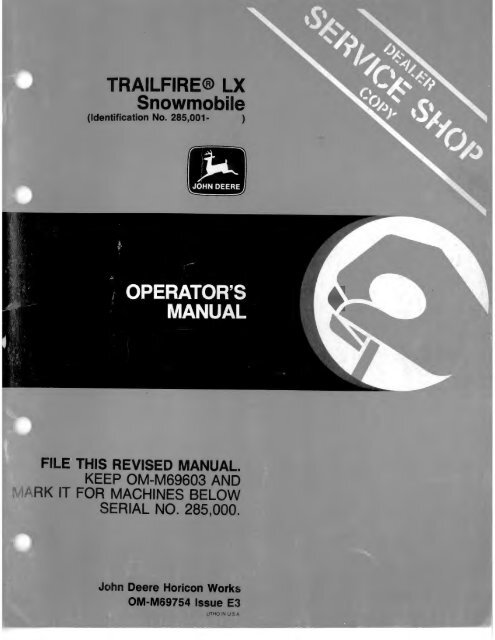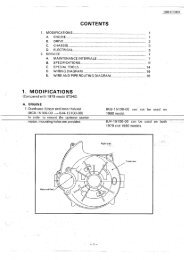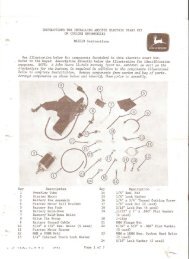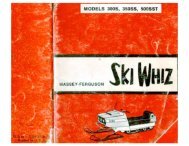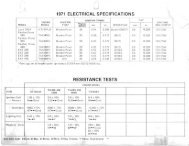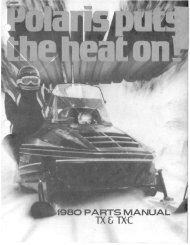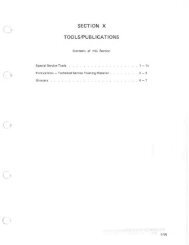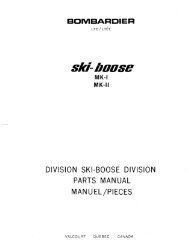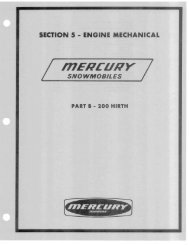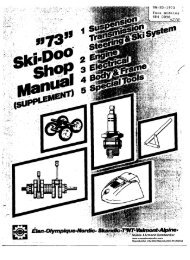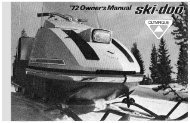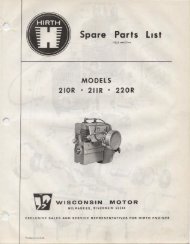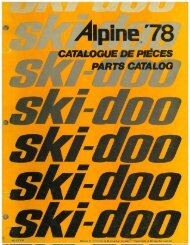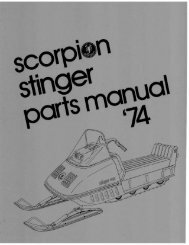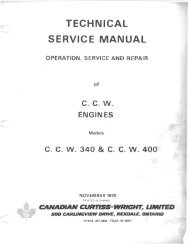John Deere - Vintage Snow
John Deere - Vintage Snow
John Deere - Vintage Snow
You also want an ePaper? Increase the reach of your titles
YUMPU automatically turns print PDFs into web optimized ePapers that Google loves.
TRAILFIRE® LX<br />
<strong>Snow</strong>mobile<br />
(Identification No. 285,001· )<br />
J.L-<br />
JOHN DEERE<br />
FILE THIS REVISED MANUAL.<br />
KEEP OM-M69603 AND<br />
ARK IT FOR MACHINES BELOW<br />
SERIAL NO. 285,000.<br />
<strong>John</strong> <strong>Deere</strong> Horicon Works<br />
OM-M69754 Issue E3<br />
LITHO IN USA
Read this manual carefully to learn how to operate and<br />
service your snowmobile correctly.<br />
SAFETY<br />
This safety alert symbol identifies important<br />
safety messages in this manual. When you<br />
see this symbol, be alert to the possibility of<br />
personal injury and carefully read the message<br />
that follows.<br />
DIRECTIONS<br />
"Right-hand" and "left-hand" sides are determined by<br />
facing in the direction of forward snowmobile travel.<br />
INTRODUCTION<br />
MEASUREMENTS<br />
This operator's manual contains Sl metric equivalents<br />
which follow immediately after the U.S. customary units<br />
of measure.<br />
WARRANTY<br />
Warranty is provided as part of <strong>John</strong> <strong>Deere</strong>'s support<br />
program for customers who operate and maintain their<br />
equipment as described in this manual.<br />
The warranty does not cover (a) <strong>John</strong> <strong>Deere</strong> snowmobiles<br />
used for competitive racing, altered for high performance<br />
or with high-performance kits; (b) products which<br />
have been altered or modified in ways not approved by<br />
<strong>John</strong> <strong>Deere</strong>, including setting fuel delivery above specifications<br />
or otherwise overpowering of products; (c) depreciation<br />
or damage caused by normal wear, accident,<br />
lack of reasonable and necessary maintenance as<br />
specified in this manual, improper maintenance, improper<br />
protection in storage, or improper use or abuse; (d)<br />
normal maintenance and replacement of service items<br />
such as filters, spark plugs, belts, brake linings, cutting<br />
blades and hoses unless such items are defective; (e)<br />
transportation, mailing and service call charges for warranty<br />
service.<br />
MACHINE NUMBERS<br />
Write the Product Identification Number and Engine<br />
Serial Number on the page provided in Specifications<br />
section. Your dealer needs this information when ordering<br />
parts.<br />
c-J I<br />
0<br />
0<br />
u<br />
M33145
ASSEMBLY<br />
c<br />
Unpack Components<br />
1. Skis<br />
2. Windshield<br />
3. Rear Bumper and <strong>Snow</strong> Flap Support<br />
4. Operator's Manual<br />
5. Bag of Parts<br />
6. Fuel Tank Cap and Gauge.<br />
c<br />
w<br />
a:<br />
w<br />
J:<br />
....<br />
:::><br />
()<br />
Check Contents of Bag of Parts<br />
A - Ski Spring Stop (2 used)<br />
B - Ski Pivot Bolt (2 used)<br />
C - 13/32 x 3/4-lnch Flat Washer (2 used)<br />
D - 3/8-lnch - 24 Lock Nut (2 used)<br />
E - Cotter Pins (2 used)<br />
F - Ignition Keys (2)<br />
G - Windshield Retaining Rings (7 used)<br />
H - <strong>John</strong> <strong>Deere</strong> Medallion<br />
1 - 114 x 1-3/ 4-lnch Cap Screws (4 used)<br />
J - 9/32 x 1 /2-lnch Flat Washer (6 used)<br />
K - 1 /4-lnch - 20 Lock Nut (6 used)<br />
L - 1/4 x 1-1/2-lnch Cap Screws (2 used)<br />
M27880<br />
c<br />
Install Skis<br />
NOTE: Bushing is factory installed in steering spindle.<br />
1. Install rubber ski spring stop over spindle. Stop is<br />
held in place by the ski saddle.<br />
2. Position ski so that rear hole of ski is aligned with<br />
spindle. Install ski bolt with head of bolt facing out.<br />
3. Install 13/32 x 3/ 4-inch flat washer and 3/8-inch<br />
lock nut. Torque nut to 39 ft-lbs (52 Nm). Install<br />
cotter pin through bolt.<br />
c
2 Assembly<br />
Install Windshield<br />
1. Bend a hook on the end of a 3/32-inch brazing rod.<br />
2. Place windshield on hood.<br />
3. Place the bent end of the rod through the hole in the<br />
windshield and hook the 0-ring.<br />
4. Pull the 0-ring halfway through hole and remove<br />
hook.<br />
J<br />
M33416<br />
Install Rear Bumper<br />
Assemble rear bumper and snow flap support to tunnel<br />
as shown.<br />
A-<strong>Snow</strong> Flap Support<br />
B-Rear Bumper<br />
C-1/4 x 1-3/4-lnch<br />
Cap Screw<br />
D-1/4 x 1-1/2-lnch<br />
Cap Screw<br />
E-9/32 x 1/2-lnch<br />
Flat Washer<br />
F- 1/4-lnch - 20 Lock Nut<br />
M33 146<br />
Position Handlebars<br />
1. Loosen lock nut securing handlebars in down position.<br />
2. Use plastic mallet to loosen aluminum block before<br />
moving handlebar.<br />
3. Move handlebar to desired position. Install two 1/4<br />
x 1-3/ 4-inch bolts and 1 I 4-inch lock nuts. Tighten<br />
all four nuts securely.<br />
4. Install <strong>John</strong> <strong>Deere</strong> Medallion.<br />
)<br />
)
Assembly 3<br />
PREDELIVERY CHECK LIST<br />
c<br />
c<br />
A<br />
CAUTION: When starting snowmobile, sup<br />
.. port machine so track is clear of ground.<br />
Check throttle for proper operation.<br />
1. Align skis ands check steering linkage.<br />
2. Check track tension and align.<br />
3. Check brakes. Adjust if necessary.<br />
4. Check operation of choke and throttle. Adjust if<br />
necessary.<br />
5. Check oil injection pump adjustment and operation.<br />
Bleed line from oil tank to pump if necessary.<br />
6. Start engine and check idle speed.<br />
7. Check speed limiter system.<br />
8. Check emergency stop and key switch.<br />
9. Check operation of all lights.<br />
10. Aim and adjust headlight.<br />
11. Test drive or dynamometer test snowmobile.<br />
12. Install accessories desired by customer.<br />
13. Check chain case oil level.<br />
DELIVERY CHECK LIST<br />
1. Explain operator's manual to customer.<br />
2. Instruct customer about snowmobile operation.<br />
c<br />
c<br />
3. Explain fuel and oil injection system. Use regular<br />
(leaded or non-leaded) gasoline with an anti-knock<br />
index of 87 or higher. DO NOT USE GASOHOL.<br />
4. Explain to customer the use of pre-mix gasoline and<br />
oil in a 50: 1 ratio for the first tank of fuel. Customer<br />
should also fill the oil tank with <strong>John</strong> <strong>Deere</strong> 2-Cycle<br />
Oil or a BIA certified 2-cycle engine oil. After break-in<br />
use gasoline only in fuel tank and 2-cycle oil in oil<br />
tank.<br />
5. Tell customer about 1 0-hour or 200 mile (322 km)<br />
check up.<br />
Break-In Period<br />
Do not exceed 40 mph (64 km/h) for the first 25 miles (16<br />
km), or force the machine at full throttle in deep snow.<br />
An occasional burst of power on hard-packed snow will<br />
not be harmful.
3A<br />
Assembly
Assembly 4<br />
PERFORM THESE 10 HOUR OR 200 MILE (322 km) CHECKS<br />
c<br />
The following inspection must be performed on your new <strong>John</strong> <strong>Deere</strong> snowmobile. This should be done at approximately<br />
the first 10 hours or 200 miles (322 km) of operation. It will help assure you of top performance and avoid<br />
premature failure of critical components. Your <strong>John</strong> <strong>Deere</strong> dealer is qualified to perform this inspection.<br />
Contact your dealer to arrange for an appointment. You are obligated to deliver the snowmobile to the dealer. Any<br />
normal maintenance or repair work required, not covered by warranty, will be charged to you should you decide to<br />
have the work done.<br />
The inspection check list is as follows:<br />
OKAY<br />
NEEDS<br />
REPAIR<br />
1. Track tension.<br />
c<br />
2. Drive belt, drive, and driven sheaves.<br />
3. Chain case oil level.<br />
4. Carburetor adjustment.<br />
5. Carburetor mounting hardware.<br />
6. Operation and adjustment of brake, throttle, oil injection pump, and choke lever<br />
controls.<br />
7. Condition of ski wear rods.<br />
8. Suspension hardware.<br />
9. Suspension slide wear bars.<br />
10. Ski alignment.<br />
11. Operation of headlight, stop-taillight, dimmer switch, and emergency stop<br />
switch.<br />
12. Fan belt tension.<br />
c<br />
13. Engine head bolts and exhaust manifold nuts.<br />
14. Steering component hardware. (Steering arms, tie rods and handlebars).<br />
DEALER COMMENTS:<br />
Dealer Name<br />
c<br />
Town ______________________________________ __<br />
Date
4A<br />
Assembly<br />
)<br />
)<br />
)<br />
)
1<br />
c<br />
Contents<br />
c<br />
c<br />
Page<br />
Safety ..... . ... . . . . ... . . .. .... ... .. . ..... 2<br />
Identification . . . . . . . . . . . . . . . . . . . . . . . . . . . . . . . 5<br />
Preparation . . . . . . . . . . . . . . . . . . . . . . . . . . . . . . . 6<br />
Fill Fuel Tank . . . . . . . . . . . . . . . . . . . . . . . . . . . . 6<br />
Fill Oil Tank . . . . . . . ... . . .. . .. . . . . . . ·. .. .. . 6<br />
Fuel Mix For Break-In Period . . . . . . . . . . . . . . . 7<br />
Fuel For Temperatures Of - 20°F (-29°C)<br />
or Below ... . ... .. . .. . ... ... . . . . .. . .. . 7<br />
Operation . . . . . . . . . . . . . . . . . . . . . . . . . . . . . . . . . 8<br />
Break-In Period . .... . . . . .... . . . ... . . .. . .. 8<br />
Before Operating . . . . . . . . . . . . . . . . . . . . . . . . . 8<br />
Starting Engine . . . . . . . . . . . . . . . . . . . . . . . . . . 8<br />
Stopping Engine . . . . . . . . . . . . . . . . . . . . . . . . . 9<br />
Lights . ..... .. . . .... .. . . ... . . .. ... . . . . . 10<br />
Towing .... .. ... .. .. . ... . .. . . ..... . . .. . 10<br />
Clearing Track . . . . . . . . . . . . . . . . . . . . . . . . . . 10<br />
Dressing For The Weather . . . . . . . . . . . . . . . . 11<br />
Transporting . . . . . . . . . . . . . . . . . . . . . . . . . . . . 11<br />
Service .. . .. . .... .... .. . .. . .. . ..... ...... 12<br />
Service Interval Chart . . . . . . . . . . . . . . . . . . . . 12<br />
Spark Plugs . . . . . . . . . . . . . . . . . . . . . . . . . . . . 13<br />
Carburetor and Oil Injection Pump . . . . . . . . . . 14<br />
Choke System . . . . . . . . . . . . . . . . . . . . . . . . 14<br />
Adjusting Choke Plunger . . . . . . . . . . . . . . . . 14<br />
Adjusting Throttle Cable . . . . . . . . . . . . . . . . 15<br />
Adjusting Oil Injection Pump . . . . . . . . . . . . . 16<br />
Replace Carburetor Main Jet . . . . . . . . . . . . . 16<br />
Carburetion Recommendations . . . . . . . . . . . 17<br />
Oil Injection Pump . . . . . . . . . . . . . . . . . . . . . 17<br />
In-Line Oil Filter . . . . . . . . . . . . . . . . . . . . . . . 17<br />
In-Line Fuel Filter. . . . . . . . . . . . . . . . . . . . . . 18<br />
Air Intake Silencer . . . . . . . . . . . . . . . . . . . . . 18<br />
Checking Fan Belt Tension . . . . . . . . . . . . . . 18<br />
Speed Limiter System . . . . . . . . . . . . . . . . . . 19<br />
Page<br />
Drive System . . . . . . . . . . . . . . . . . . . . . . . . . . . 19<br />
Servicing Drive and Driven Sheaves . . . . . . . 19<br />
Replacing Drive Belt . . . . . . . . . . . . . . . . . . . 19<br />
Adjusting Brake . . . . . . . . . . . . . . . . . . . . . . . 20<br />
Checking Chain Case Oil Level . . . . . . . . . . . 20<br />
Checking Chain Tensioner . .. .. ... . ...... 20<br />
Slide Suspension . . . . . . . . . . . . . . . . . . . . . . . . 21<br />
Replacing Wear Bars . . . . . . . . . . . . . . . . . . . 21<br />
Adjusting Track Tension .. . . .... .. . ... . . 21<br />
Adjusting Suspension Springs . . . . . . . . . . . . 22<br />
Skis . .... . .... . . ... ........ ....... .... 23<br />
Replacing Ski Wear Rods . . . . . . . . . . . . . . . 23<br />
Replacing Ski Wear Plates . . . . . . . . . . . . . . 23<br />
Aligning Skis . . . . . . . . . . . . . . . . . . . . . . . . . 24<br />
Eliminating Loose Steering . . . . . . . . . . . . . . 24<br />
Lighting System . . . . . . . . . . . . . . . . . . . . . . . . . 25<br />
Adjusting Headlight . . . . . . . . . . . . . . . . . . . . 25<br />
Replacing Headlight Bulb . . . . . . . . . . . . . . . . 26<br />
Replacing Stop-Taillight Bulb . .. .. . ....... 26<br />
Replacing Speedometer and Tachometer<br />
Bulbs . .... . . . .. . ... . .... · .. . .. .. . .. 26<br />
Lubrication . . . . . . . . . . . . . . . . . . . . . . . . . . . . . . . 27<br />
Steering Column Bushing . . . . . . . . . . . . . . . . . 27<br />
Track Drive Shaft Bearing . . . . . . . . . . . . . . . . . 27<br />
Tightening Hardware and Components . . . . . . . . . 28<br />
Adjusting Glove Box Door Latch . . . . . . . . . . . . . . 28<br />
Storage ........ .. . . ...... .. .. .. . .. ... ... 29<br />
Trouble Shooting . . . . . . . . . . . . . . . . . . . . . . . . . . 30<br />
Specifications . . . . . . . . . . . . . . . . . . . . . . . . . . . . . 32<br />
Product Identification Number . . . . . . . . . . . . . . . . 33<br />
Engine Serial Number . . . . . . . . . . . . . . . . . . . . . . 33<br />
Accessories . . . . . . . . . . . . . . . . . . . . . . . . . . . . . . 34<br />
c<br />
OOA
Safety<br />
CAUTION: Improper use or maintenance<br />
by the operator can result in injury. Follow<br />
these safety suggestions.<br />
Preparation<br />
Before starting the engine, read your operator's manual<br />
from cover to cover. Knowledge can prevent ac- )<br />
cidents.<br />
Always operate your throttle and brake controls several<br />
times before you start your engine. Stuck or frozen<br />
controls could cause serious injury or damage.<br />
Know your controls. Learn how to stop in an emergency.<br />
Know your state, provincial, federal and local laws<br />
pertaining to snowmobiling. Respect property of<br />
others. Don't spoil this fine winter sport by creating a<br />
bad image.<br />
Never add fuel when smoking or while engine is running.<br />
Use a safe gasoline container. Always use fresh,<br />
clean fuel of the proper mixture. See pages 6 and 7.<br />
M23365<br />
Wear clothing designed for snowmobiling . .. avoid<br />
frostbite. Never wear scarves, loose belts, or clothes<br />
that could catch on moving parts or tree limbs.<br />
Always wear eye and headgear protection to guard<br />
against injury.<br />
Prolonged exposure to loud noise can cause impairment<br />
or loss of hearing. Wear earplugs or any suitable<br />
hearing protective device that is comfortable when<br />
wearing a snowmobile helmet to protect against objectionable<br />
or uncomfortable loud noises. Always wear<br />
an approved helmet to guard against head injury.<br />
A void sun blindness. Wear properly tinted goggles or<br />
face shields. Never wear yellow eye protection in the<br />
bright sun.<br />
Do not allow anyone to operate snowmobile without<br />
proper instructions. Take proper precautions before<br />
allowing young operators to drive.<br />
Always use the "buddy system". Remember you can )<br />
drive farther in 30 minutes than you can walk in a day.<br />
Carry adequate tools and repair items for emergency<br />
field repairs.<br />
Don't overload your snowmobile . .. use sleds to carry<br />
provisions.
Safety 3<br />
c<br />
c<br />
c<br />
c<br />
Always carry emergency survival supplies when going<br />
on long trips. Let friends and relatives know your<br />
destination and expected arrival time.<br />
Operation<br />
Give complete and undivided attention to your snowmobile<br />
. .. don't be a show-off.<br />
Do not operate snowmobile in crowded areas or steer<br />
the machine toward persons.<br />
Do not operate snowmobile too close to avalanche<br />
areas, or on other unsafe terrain where spills could<br />
occur.<br />
Observe all state, provincial, federal and local regulations,<br />
especially those with regard to operating on<br />
streets and highways.<br />
When crossing highways (where permitted by law)<br />
always stop, look both directions, and cross at a 90-<br />
degree angle. Post guards when crossing in groups.<br />
Do not operate snowmobiles on or near railroad tracks.<br />
Trains cannot always be heard above sound of snowmobile<br />
engine .. . it is difficult to escape from between<br />
tracks.<br />
Skiers and snowmobiles don't mix on the same hillsides.<br />
Avoid ski slopes.<br />
Never operate snowmobile on rivers or lakes without<br />
first checking thickness of ice. If you go through the ice,<br />
don't panic. Conserve energy.<br />
Never operate snowmobile at night without lights. Keep<br />
headlight and taillight areas free of snow.<br />
Keep all shields in place . .. all guards and protective<br />
hoods.<br />
Never open new trails at night. Follow established<br />
trails. Unseen barbed wire or guy wires can cause<br />
serious injury or death.<br />
Always use both hands for steering.<br />
Avoid operating snowmobile at excessive speed.<br />
Always be aware of terrain.<br />
If throttle sticks, don't panic. Turn emergency stop<br />
switch on the right-hand handlebar. See page 9.<br />
Always allow adequate stopping distance based on<br />
ground cover conditions. Remember, ice requires a<br />
greater stopping distance. To avoid skidding, don't<br />
apply brakes rapidly on ice.<br />
Ice or hard surfaces do not provide the same stability<br />
as snow. Drive slower on these surfaces. Do not<br />
accelerate rapidly.<br />
Be sure tool box lid is closed at all times. An open lid<br />
could cause interference with steering or possible<br />
contact with the throttle lever producing unexpected<br />
acceleration.<br />
M23364<br />
M23366
4 Safety<br />
Do not speed through wooded areas. Hidden obstructions,<br />
hanging limbs, unseen ditches, and even wild<br />
animals can cause accidents.<br />
Do not tailgate when riding trails. Rear end collisions<br />
can cause injury and machine damage.<br />
Don't mix alcoholic beverages with snowmobiling.<br />
Keep feet on footrests at all times. Do not permit them<br />
to hang over sides. Do not attempt to stabilize machine<br />
with feet when making turns or in near-spill situations.<br />
Broken limbs could result.<br />
Select a riding position suited to the terrain upon which<br />
you're operating. Do not stand on seat, stunt, or<br />
show-off.<br />
Do not jump snowmobile. Operator injury or machine<br />
damage could result.<br />
Keep hands and feet out of the track area . .. be especially<br />
careful when freeing your snowmobile from deep<br />
snow.<br />
When towing a sled, use a solid towbar. Do not use<br />
ropes or other flexible tow straps. See page 10.<br />
Observe fuel supply regularly. Do not travel farther<br />
than your fuel will permit you to return.<br />
Remove key from switch whenever you leave your<br />
machine unattended.<br />
Never drive your snowmobile onto a tilt-bed trailer.<br />
Winch it on.<br />
Always secure snowmobile firmly to trailer. Be sure<br />
trailer lights are operative.<br />
)<br />
)<br />
Maintenance and Storage<br />
Check over your snowmobile regularly. This will pre- )<br />
vent many problems from occurring.<br />
Do not attempt to make repairs to your snowmobile<br />
while engine is running.<br />
Keep matches away and do not smoke while filling the<br />
fuel tank. Avoid possible explosions.<br />
Check skis and steering components frequently to see<br />
they are in good condition. Keep all hardware tight.<br />
Never lift the rear of the snowmobile to clear the track.<br />
Chunks of ice or rocks may be thrown rearward. Tilt<br />
machine on one footrest when clearing track .. . and<br />
keep all persons clear of area. Keep hands and feet<br />
clear of track.<br />
M221 22
5<br />
c<br />
Identification<br />
c<br />
A-Shock Absorbers<br />
B- Skis<br />
C-Front Bumper<br />
D-Hood<br />
E-Headlight<br />
F -Windshield<br />
G-Brake Control<br />
H-Seat<br />
I -Rear Bumper<br />
J - Track<br />
K-Pan<br />
L - Ski Spring<br />
M33147<br />
c<br />
A-<strong>Snow</strong> Flap<br />
B- Hitch<br />
C-Rear Bumper<br />
D-Stop-Taillight<br />
E-Seat<br />
F-Throttle Control<br />
G-Fuel Tank<br />
H-Hood<br />
I - Ski Handle<br />
J - Recoil Start<br />
K-Track<br />
L-<strong>Snow</strong>mobile<br />
Serial Number<br />
c<br />
M33 148
Preparation<br />
FILL FUEL TANK<br />
A CAUTION: Use safe refueling procedures.<br />
Fuel snowmobile outdoors.<br />
Do not smoke.<br />
Avoid spilling fuel. Do not overfill.<br />
Clean area around fuel tank of any spilled fuel.<br />
Fill tank to bottom of filler neck.<br />
J<br />
M33149<br />
IMPORT ANT: Use regular leaded or un-leaded gasoline<br />
with an anti-knock index of 87 or<br />
higher. Never use gasoline that has<br />
been stored for a long time.<br />
NOTE: Regular leaded gasoline is preferred but unleaded<br />
gasoline is acceptable. DO NOT use<br />
gasoline-alcohol mixtures, such as gasohol, or<br />
ethynol-blend gasoline.<br />
NOTE: When running snowmobile in powder snow or<br />
blowing snow add gasoline de-icer to the fuel<br />
tank. Use ONLY one 12-ounce (355 mL) can per<br />
tank of fuel.<br />
CAUTION: Excessive amounts of gasoline<br />
de-icer will lean out the fuel mixture and could<br />
cause engine damage.<br />
FILL OIL TANK<br />
M28307<br />
NEVER ALLOW OIL TANK TO BECOME EMPTY.<br />
MAINTAIN AT LEAST 3 INCHES (76 MM) OF OIL IN<br />
BOTTOM OFT ANK AT ALL TIMES. Use <strong>John</strong> <strong>Deere</strong> 2-<br />
cycle oil or a BIA approved 2-cycle engine oil. Oil tank<br />
holds 3.5 U.S. pints (1.7 L).<br />
IMPORTANT: If other than <strong>John</strong> <strong>Deere</strong> 2-cycle oil is<br />
used, it must meet BIA (Boating Industry<br />
Association) test qualification<br />
TCW.<br />
Never use dirty or contaminated oil.<br />
The oil and oil tank must remain clean<br />
to avoid oil injection pump failure and<br />
engine damage.<br />
)<br />
)
Preparation 7<br />
FUEL MIX FOR BREAK-IN PERIOD<br />
c<br />
For the first tank of fuel, pre-mix gasoline and oil in a<br />
50:1 ratio (1 pint of oil with 6 U.S. or 5 Imperial gallons)<br />
and fill fuel tank. Fill the oil tank with <strong>John</strong> <strong>Deere</strong> 2-cycle<br />
oil or its equivalent.<br />
After the break-in period, use ONLY GASOLINE in the<br />
fuel tank and <strong>John</strong> <strong>Deere</strong> 2-cycle oil or its equivalent in<br />
the oil tank.<br />
FUEL FOR TEMPERATURES OF -20°F (-29°C) OR BELOW<br />
c<br />
IMPORTANT: Use a 50:1 gasoline and oil pre-mix in<br />
the fuel tank and fill the oil tank with 2-<br />
cycle oil. DO NOT use straight gasoline<br />
in the fuel tank. The oil injection<br />
system may not function efficiently at<br />
-20°F (-29°C) and this could cause<br />
engine failure.<br />
c<br />
c
Operation<br />
)<br />
BREAK-IN PERIOD<br />
Do not exceed 40 mph (64 km/h) for the first 25 miles (16<br />
km), or force the machine at full throttle in deep snow.<br />
An occasional burst of power on hard-packed snow will<br />
not be harmful. Operating snowmobile above 40°F<br />
(5°C) may result in hard starting or reduced performance,<br />
especially at high altitudes.<br />
BEFORE OPERATING<br />
1. Clean windshield with a damp cloth. Do not use gasoline,<br />
solvents, or abrasive cleaners.<br />
2. Check skis, wear rods, and all steering components.<br />
Check steering for a full right and left-hand turn.<br />
3. Check track for proper tension.<br />
4. Check fuel level.<br />
STARTING ENGINE<br />
CAUTION: Be sure area in front of machine is<br />
clear. Be prepared to apply brake to prevent<br />
snowmobile movement.<br />
Cold Starting<br />
Normal Choke<br />
M2537 1Y<br />
Richer Choke<br />
M25372Y<br />
1. With no choke and no throttle, pull recoil start to turn<br />
engine over two or three times.<br />
2. Flip choke lever straight up (normal position). In extremely<br />
cold weather, flip choke over center all the<br />
way (richer position).<br />
3. Emergency stop switch must be in center position.<br />
4. Turn key switch "ON". DO NOT press throttle lever.<br />
5. Pull recoil start rope.<br />
6. When engine starts, allow it to run briefly before<br />
pushing choke lever down.<br />
NOTE: If choke was in rich position, push down to normal<br />
position and allow engine to warm up.<br />
7. If engine becomes ''flooded'·, close the choke. Hold<br />
the throttle in wide open position. Pull start rope until<br />
engine "pops". Release throttle. Pull recoil start rope<br />
until engine starts.<br />
NOTE: Remove and dry plugs if engine is extremely<br />
flooded.<br />
IMPORTANT: DO NOT permit engine to idle for long<br />
intervals. Shut engine off whenever<br />
you stop.<br />
) .<br />
)<br />
M33150
Operation 9<br />
c<br />
Warm Starting<br />
1. Emergency stop switch must be in center position.<br />
2. Turn key switch "ON".<br />
3. Pull recoil start rope.<br />
NOTE: DO NOT use choke.<br />
Emergency Starting<br />
1. Raise the hood.<br />
NOTE: Leave belt guard in place. Do not raise or remove<br />
it.<br />
2. Push secondary clutch in slightly to relieve belt ten~<br />
sian. This allows for easier starting.<br />
3. Wind rope counterclockwise around clutch.<br />
CAUTION: DO NOT wind rope around your<br />
hand. Use "T" handle from tool kit. When<br />
starting engine, use a sharp, crisp pull on rope<br />
so rope comes free of clutch. DO NOT allow<br />
rope to become tangled in drive belt when engine<br />
starts.<br />
4. Keep all people clear of snowmobile when starting<br />
engine with emergency start procedure.<br />
CAUTION: Knotted end of rope comes free of<br />
clutch when rope is pulled. Knotted end could<br />
snap into a bystanders face and cause personal<br />
injury.<br />
1. Release throttle lever.<br />
2. Turn emergency stop switch up or down.<br />
( 3. Apply brake.<br />
4. Before restarting, emergency stop switch must be<br />
turned to center position. Always check emergency<br />
stop switch before attempting to start engine.<br />
5. Turn key switch "OFF". Remove key before leaving<br />
machine unattended.<br />
STOPPING ENGINE<br />
c<br />
M3315 1
10 Operation<br />
LIGHTS<br />
NOTE: The lights are automatically "ON" whenever<br />
the engine is running.<br />
1. Stoplight comes on when brake is applied.<br />
2. Turn dimmer switch to low beam.<br />
3. Turn dimmer switch again for high beam.<br />
NOTE: If one filament of bulb fails, the other beam can<br />
still be used. See pages 25 and 26 for adjusting<br />
headlight and changing bulbs.<br />
)<br />
M24911<br />
TOWING<br />
M28322<br />
A<br />
CAUTION: Always use a solid tow bar<br />
when possible. Flexible ropes or pull<br />
straps do not allow for control on turns or<br />
for stopping.<br />
1. Remove the drive belt.<br />
2. Connect only one ski of disabled machine to the tow<br />
machine.<br />
3. DO NOT use rear bumper for towing.<br />
4. When towing with a rope or strap, run rope through<br />
ski handle and around ski spindle. Do not loop rope<br />
or strap through both skis. This may damage the<br />
steering tie rod.<br />
CLEARING TRACK<br />
)<br />
1. Clear track after operating in slushy snow.<br />
2. Tip machine on its left side until track clears the<br />
ground.<br />
3. Spin track at moderate speed until snow and ice are<br />
thrown clear.<br />
A<br />
CAUTION: Be sure no one is behind machine<br />
when clearing track. Injury could result<br />
from ice or rocks thrown from track.<br />
IMPORTANT: If track freezes, free it manually. Do<br />
not use the engine to break track<br />
loose. The drive belt will be burned<br />
and damaged.<br />
)
Operation 11<br />
DRESSING FOR THE WEATHER<br />
c<br />
c<br />
1. To prevent frostbite, dress for the wind and<br />
weather.<br />
2. Wear protective clothing and accessories.<br />
3. The chart provides a guide and illustrates the<br />
danger zones.<br />
CAUTION: Always wear a snowmobile<br />
helmet. The helmet provides both warmth<br />
and protection against head injury.<br />
WIND CHILL CHART<br />
ESTIMATED<br />
WIND SPEED<br />
IN MPH<br />
ACTUAL THERMOMETER READING (°F.)<br />
50 40 30 20 10 0 -1 0 -20 -30<br />
EQUIVALENT TEMPERATURE (°F.)<br />
calm 50 40 30<br />
20~-30<br />
5 48 37 27 16 6 -5 -15 -26 -36<br />
10 40 28 16 4 -9 -21 -33 -46 -58<br />
15 36 22 9 -5 -18 -36 -45 -58 -72<br />
20 32 18 4 -1 0 -25 -39 -53 -67 -82<br />
25 30 16 0 -15 -29 -44 -59 -74 -88<br />
30 28 13 -2 -18 -33 -48 -63 -79 -94<br />
35 27 11 -4 -20 -35 -49 -67 -82 -98 -113<br />
40 26 10 -6 -21 -37 -53 -69 -85 -100 . -116<br />
(Wind speeds LITTLE INCREASING greater than<br />
GREAT<br />
40 mph have DANGER DANGER DANGER<br />
littleaddi·<br />
(for properly clothed<br />
tional effect) person) Danger from freezing of exposed flesh<br />
-40<br />
-40<br />
-47<br />
-70<br />
-85<br />
-96<br />
-104<br />
-109<br />
-50 -60<br />
-50 -60<br />
-57 -68<br />
-83 -95<br />
-99 -112<br />
-110 -124<br />
-118 -133<br />
-125 -140<br />
-129 -145<br />
-132 -148<br />
M10123<br />
c<br />
Close fuel shut-off valve when transporting the snowmobile.<br />
Shut-off valve should also be closed when<br />
snowmobile is stored. Valve is off when handle is<br />
straight up.<br />
TRANSPORTING<br />
c<br />
M30587
Service<br />
)<br />
SERVICE INTERVAL CHART<br />
Every Every<br />
As 150 300<br />
Item Needed Daily Miles Miles Annually Page<br />
Clean windshield. X 8<br />
Check condition of skis and steering. X 23,24<br />
Check track condition and tension. X 21,22<br />
J<br />
Check throttle control operation. X 14, 15,16<br />
Check operation of brakes. X 20<br />
Check emergency stop and key switch. X 9<br />
Check lighting system. X 10<br />
Check chain case oil level. X 20<br />
Check chain tensioner. X 20<br />
Check in-line fuel filter. X 18<br />
Check in-line oil filter. X 17<br />
Check oil injection pump. X 17<br />
Grease L.H. track drive shaft bearing. X 27<br />
Grease steering column bearing. X 27<br />
Check drive belt condition. X 19<br />
Check carburetor adjustments. X X X 14,1 5,1 6<br />
Check choke adjustments. X X X 14<br />
Check fan belt tension. X X 18<br />
Check ski alignment. X 24 )<br />
Check headlight adjustment. X 25<br />
Check ski wear rods and wear plates. X X 23<br />
Check slide suspension wear bars. X X 21<br />
Lubricate throttle cable. X 16<br />
Check all components for condition and<br />
tightness. X 28<br />
Service drive and driven sheaves. X 19<br />
Store snowmobile properly. X 29<br />
)<br />
·•
Service 13<br />
SPARK PLUGS<br />
c<br />
c<br />
Removing Spark Plugs<br />
A<br />
CAUTION: High-energy ignition systems can<br />
produce injurious electrical shock. Stop engine<br />
and remove key before working on ignition.<br />
1. Stop engine.<br />
2. Pull spark plug wire connectors from plugs.<br />
IMPORTANT: Do not pull on wire to remove connectors.<br />
Pull on connectors only.<br />
3. Remove plugs.<br />
Checking Spark Plugs<br />
A<br />
CAUTION: Do not hold the plug or plug wire in<br />
your hand when checking for spark. Do not<br />
remove plugs from engine for this test. If<br />
crankcase is full of fuel and engine is turned<br />
over, gasoline may spew out spark plug hole,<br />
causing a fire hazard.<br />
1. Reconnect spark plug wire to a new spare plug.<br />
2. Lay plug on engine.<br />
3. With ignition "ON," pull recoil start rope and check<br />
for spark.<br />
New plugs are gapped at 0.025 inch (0.635 mm). The<br />
gap will widen in proportion to the hours and miles of<br />
use. When plug gap reaches 0.045 inch (1 .143 mm), or if<br />
plug malfunctions, replace it.<br />
c<br />
Plug Appearance<br />
Tan or Cocoa Brown<br />
Black or Sooty<br />
White or Light Tan<br />
Possible Cause<br />
Proper fuel mixture, good<br />
combustion.<br />
Fuel mixture too rich, poor<br />
combustion.<br />
Fuel mixture too lean, hot<br />
combustion.<br />
M3C882<br />
NOTE: Replace plug if appearance is abnormal, engine<br />
starts hard or malfunctions.<br />
( Installing Spark Plugs<br />
1. Clean plug seating surface on cylinder head.<br />
2. Install plugs and tighten to 20 ft-lbs (27 N·m) torque.<br />
3. Connect spark plug wires.
14 Service<br />
CARBURETOR AND OIL INJECTION PUMP<br />
IMPORTANT: DO NOT run engine when adjusting<br />
carburetor.<br />
The carburetor is a float-type, fixed main jet carburetor.<br />
The float in the fuel bowl maintains a constant fuel level<br />
in the bowl. The fixed main jet eliminates high-speed<br />
adjustments. Altitude and temperature variations may<br />
require main jet changes.<br />
IMPORTANT: DO NOT run engine with air intake<br />
silencer removed. To do so will<br />
cause engine to run lean and could<br />
cause engine failure.<br />
Choke System<br />
A separate metered choke system is used. The system<br />
is opened and closed by a choke plunger. Do not open<br />
the throttle when starting the engine, otherwise the<br />
fuel-air mixture will be too lean for starting.<br />
)<br />
Adjusting Choke Plunger<br />
1. Remove air intake silencer.<br />
2. Place choke lever down (closed).<br />
3. Look in the choke plunger hole in the carburetor<br />
throat. Plunger should be all the way down in the<br />
bore.<br />
NOTE: There should be slight freeplay between choke<br />
lever and dash when plunger is all the way<br />
down and console is in the down position.<br />
4. To adjust plunger, loosen jam nut and turn adjusting<br />
sleeve clockwise. This moves plunger down. Tighten<br />
jam nut.<br />
IMPORTANT: Plunger must be down tight in bore<br />
or the carburetor will run "rich". This<br />
will affect engine performance.<br />
5. Raise choke lever and look in choke plunger hole.<br />
Plunger should raise enough to expose at least half<br />
the hole opening.<br />
)<br />
)
Service 15<br />
c<br />
c<br />
Adjusting Throttle Cable<br />
1. Remove air intake silencer.<br />
. 2. Lock throttle lever against handgrip with a clamp<br />
or strong rubber band.<br />
3. Place your finger in throat of carburetor so you can<br />
feel the backside of the throttle valve.<br />
4. Loosen jam nut and turn adjusting sleeve until the<br />
backside of throttle valve is flush with the bore.<br />
Tighten jam nut<br />
NOTE: No part of the throttle valve should restrict air<br />
flow through the carburetor throat when throttle<br />
is in the wide open position. Use Never<br />
Seez on the throttle cable end in the throttle<br />
lever.<br />
5. Turn idlle adjusting screw (B) counterclockwise<br />
until the tip is flush with inside of bore.<br />
6. Remove clamp or rubber band from throttle lever.<br />
This allows throttle valve to fully seat in bore.<br />
7. Turn idle adjusting screw (B) clockwise until screw<br />
contacts throttle valve. Turn screw clockwise two<br />
additional turns. This gives preliminary idle speed.<br />
8. Look into throat of carburetor and slowly c.ompress<br />
the throttle lever. The throttle valve should begin to<br />
rise; if not, repeat Steps 2, 3, and 4.<br />
9. Turn air screw (A) in until slight seating resistance<br />
is felt<br />
10. Back air screw (A) out 1 turn.<br />
11. Install air intake silencer and run engine until operating<br />
temperature is reached. If idle speed is not correct,<br />
turn idle adjusting screw (B) in or out until idle<br />
speed is correct (2000 to 2200 rpm).<br />
IMPORT ANT: NEVER use air screw (A) to set engine<br />
idle. Air screw should be adjusted as<br />
explained in Step 10.<br />
c
16 Service<br />
Adjusting Oil Injection Pump<br />
IMPORTANT: The oil injection pump lever must be<br />
adjusted to move at exactly the same<br />
time that the carburetor throttle valve<br />
starts to rise.<br />
Adjust oil injection pump as follows:<br />
M28363<br />
1. Loosen the two jam nuts securing the oil injection<br />
pump control cable adjusting sleeve.<br />
2. Back sleeve out to tighten cable or turn in to loosen<br />
cable. Cable should have slight free-play; it should<br />
not be stretched tight.<br />
3. Press the throttle lever on the handgrip and observe<br />
throttle valve and oil injection pump control lever. )<br />
The throttle valve and lever should start to move at<br />
exactly the same time.<br />
4. When adjustment is correct, marks will align. Tighten<br />
the jam nuts securing the oil injection pump control<br />
cable adjusting sleeve.<br />
IMPORT ANT: Lubricate throttle cable once each<br />
season with LPS or W0-40. Hold the<br />
throttle lever against the handgrip and<br />
allow lubricant to run down cable. DO<br />
NOT use engine oil or silicon spray.<br />
These lubricants may destroy the<br />
plastic components of the throttle cable<br />
or cause control cable to become<br />
sticky in cold temperatures.<br />
Replace Carburetor Main Jet<br />
1 . Remove throttle valve assembly from top of carburetor.<br />
2. Loosen clamp securing carburetor to intake manifold.<br />
3. Remove clamp securing intake silencer boot to carburetor.<br />
Do not remove boot from carburetor.<br />
4. Turn carburetor 90 degrees.<br />
)<br />
A-Mixing Chamber<br />
M30588<br />
B-Fioat Arm<br />
CAUTION: Fuel in carburetor float bowl drains<br />
out when hex. plug is removed. Place sufficient<br />
material under carburetor to soak up<br />
spilled fuel, when plug is removed. Avoid fires<br />
due to smoking or careless maintenance practices.<br />
5. Use a 17 mm wrench to remove hex. plug from bottom<br />
of carburetor.<br />
6. Replace main jet.<br />
7. Reverse procedure to install carburetor.<br />
)
Service 17<br />
CARBURETION RECOMMENDATIONS<br />
c<br />
c<br />
4000 ft. (1210 m)<br />
Sea Level to<br />
to<br />
Temperature Component 4000 ft. (1219 m) 8000 ft. (2438 m)<br />
Below 0°F (-18°C) Main Jet 240 230<br />
Above 0°F (-18°C) Main Jet 230 220<br />
Jet Needle 6F27-3 6F27-3<br />
Needle Jet 166-QO 166-QO<br />
All Temperatures Throttle Valve 3.5 3.5<br />
Pilot Jet 25 25<br />
Air Screw 1 Turn Open 1 Turn Open<br />
Idle Speed 1800-2300 rpm 2700-3200 rpm<br />
8000 ft. (2438 m)<br />
and Above<br />
210<br />
200<br />
6F27-3<br />
166-QO<br />
3.5<br />
25<br />
1 Turn Open<br />
2700-3200 rpm<br />
Check oil flow annually. See your <strong>John</strong> <strong>Deere</strong> dealer for<br />
this service.<br />
OIL INJECTION PUMP<br />
c<br />
IN-LINE OIL FILTER<br />
Replace oil filter annually or immediately if oil level in tank<br />
does not drop. Minimum oil level at bottom of tank must<br />
be 3 inches (76 mm) for oil pump to function correctly. \\<br />
'I<br />
M28311<br />
r<br />
M283t2
18 Service<br />
IN-LINE FUEL FIL TEA<br />
Change the filter annually or when contamination<br />
builds up.<br />
)<br />
)<br />
AIR INTAKE SILENCER<br />
The first indication of trash in the silencer will be loss of<br />
power and performance. The engine will run "rich"<br />
because adequate air will not be mixing with the fuel.<br />
1. Remove silencer.<br />
2. Shake or blow out silencer to remove any trash.<br />
3. Install silencer.<br />
IMPORTANT: DO NOT run engine with air intake<br />
silencer removed. Serious engine<br />
damage will result.<br />
CHECKING FAN BELT TENSION<br />
Remove fan cover.<br />
Use your finger to deflect belt as shown. If more than<br />
3/8-inch (9.52 mm) . deflection is possible or if belt<br />
condition is questionable, see your <strong>John</strong> <strong>Deere</strong> dealer.
Service 19<br />
SPEED LIMITER SYSTEM<br />
The function of the speed limiter system can be checked<br />
by holding the throttle lever pin rearward and pressing<br />
the throttle lever slowly. If the system is functioning<br />
correctly, the engine will "miss" or "cut out" at 2800 to<br />
3000 rpm.<br />
The speed limiter system provides two types of protection;<br />
it limits engine speed to 2800 to 3000 rpm if the<br />
throttle lever is released and the carburetor slides stick<br />
open and it limits maximum engine speed to 7800 to<br />
8400 rpm in the event of a broken belt at wide open<br />
throttle.<br />
c<br />
DRIVE SYSTEM<br />
Servicing Drive and Driven Sheaves<br />
Once a year, service the drive and driven sheaves. See<br />
your <strong>John</strong> <strong>Deere</strong> dealer for this service.<br />
Replacing Drive Belt<br />
The drive belt should be replaced if its width is reduced<br />
by 1/8 inch (3.18 mm). A narrow belt reduces snowmobile<br />
top speed. Correct' width is 1-1/4 inches (31.75<br />
mm).<br />
c<br />
If drive belt wears rapidly, drive and driven sheaves<br />
may be out of alignment. See your <strong>John</strong> <strong>Deere</strong> dealer.<br />
A belt worn narrow in one area is caused by trying to<br />
free a frozen track with the engine. Free a frozen track<br />
manually before starting engine.<br />
A<br />
CAUTION: Keep fingers out of area between<br />
driven sheave halves. If driven<br />
sheave sticks, use care in opening it to<br />
prevent hand from being pinched.<br />
1 . Push in on center of driven sheave and rotate clockwise<br />
and lift belt up and over sheave half.<br />
2. Remove belt from drive sheave.<br />
c<br />
IMPORTANT: Never pry belt over sheaves.<br />
3. Install belt in reverse sequence. Always install belt<br />
so that number on belt can be read when viewed<br />
from the left-hand side of the snowmobile.<br />
NOTE: As belt wear increases or if belt stretches,<br />
remove spacer washer (A) from behind retaining<br />
washer (8). When new belt is installed,<br />
replace washer. Torque cap screw to 20 ft-lbs<br />
(27 Nm). If snowmobile has a tendency to<br />
creep at idle speed after installing a new belt,<br />
add a washer.<br />
A-Spacer Washer<br />
M27809<br />
8-Retaining Washer
20 Service<br />
Adjusting Brake<br />
1 . Apply the brake control lever and measure the<br />
distance from the lever to the handgrip. It should be<br />
1 to 1-1/2 inches (25 to 38 mm).<br />
2. Adjust brake by loosening jam nut and turning cap<br />
screw in. Retighten jam nut securely.<br />
/';. CAUTION: DO NOT adjust jam nuts on<br />
.. brake cable.<br />
3. Check brake tension.<br />
4. Readjust if necessary.<br />
NOTE: Be certain dowel on end of brake cable is<br />
seated properly in recess of brake control<br />
lever.<br />
5. After brake adjustment, check operation of stoplight )<br />
switch. If stoplight does not work, check for a defective<br />
switch.<br />
Checking Chain Case Oil Level<br />
1. Park snowmobile on a level surface.<br />
2. Remove lower plug from chain case. If oil flows from<br />
this hole, oil level is satisfactory.<br />
3. To add oil, remove upper plug and add API-GLS gear<br />
oil (SAE 90) until it flows from lower hole.<br />
4. Install plugs.<br />
M28314<br />
Checking Chain Tensioner<br />
1. Turn snowmobile on its left side. Remove chain<br />
case cover.<br />
2. Check chain tensioner for wear. When tensioner is<br />
worn until only 1/16 inch (1 .588 mm) of material<br />
remains, replace the tensioner.<br />
3. Install cover. Add oil to chain case if required. Wipe<br />
any spilled fuel from the pan or sheaves.<br />
)<br />
)
Service 21<br />
SLIDE SUSPENSION<br />
c<br />
c<br />
The slide suspension system requires lubrication between<br />
the plastic wear bar and metal grouser bar. The<br />
absence of lubrication (snow or water) causes the<br />
plastic wear bar to wear rapidly and in severe cases,<br />
literally melt away.<br />
Operation of the snowmobile under the following conditions<br />
should be avoided.<br />
1. Dirt<br />
2. Rocks<br />
3. Sand<br />
4. Grass<br />
5. Bare Pavement<br />
6. <strong>Snow</strong> permeated with dirt and sand.<br />
7. Glare ice surfaces<br />
IMPORT ANT: When running on ice or hard packed<br />
snow at high-speed, the wear bars<br />
will heat up. Either reduce speed, or<br />
frequently stop and apply ice or<br />
snow to the track to lubricate the<br />
wear bars.<br />
Replacing Wear Bars<br />
When running in marginal snow conditions, check wear<br />
bars daily.<br />
1. Tip snowmobile on its side.<br />
2. Check wear bars in several places for cracks, thin<br />
areas and sand or gravel imbedded in the bar.<br />
NOTE: Sand or gravel imbedded in the wear bars acts<br />
as an abrasive and will destroy the steel<br />
grouser bars in the track.<br />
c<br />
c<br />
3. If any of these conditions exist, see your <strong>John</strong><br />
<strong>Deere</strong> dealer for wear bar replacement.<br />
Adjusting Track Tension<br />
Check track tension and alignment frequently. A loose<br />
track causes excessive slap and could damage the<br />
track, tunnel or slide assembly. A tight track requires<br />
additional power to operate.<br />
1. Suspend or support snowmobile so track is clear of<br />
ground.<br />
2. Loosen jam nuts (A) on track adjusting screws (B).<br />
3. Turn adjusting screws (B) to tension track.<br />
4. Measure below the lower shock absorber mount for<br />
clearance of flush to 1 I 4 inch (6.35 mm) between<br />
track and slide wear bar. Both sides should be<br />
equal. Tighten jam nuts.<br />
A-Jam Nuts<br />
B-Adjusting Screws
22 Service<br />
After Adjusting Track Tension<br />
1. Start engine and allow track to rotate slowly several<br />
times. Shut off engine and allow track to coast to a<br />
stop. DO NOT APPLY BRAKE TO STOP TRACK.<br />
2. Check alignment. Rear idler wheels should run in<br />
center of drive lugs.<br />
3. Slide rail wear bar should be in middle of each slide<br />
rail opening of track.<br />
4. If either Step 2 or 3 indicates a need for adjustment,<br />
repeat the procedure.<br />
NOTE: Track will run to the loose side. If track is too<br />
far to the left, tighten the left adjusting screw to<br />
move the track to the right.<br />
Adjusting Suspension Springs<br />
Ride the snowmobile to determine adjustment requirements.<br />
Front Springs<br />
If the front springs are tightened too much, the ride will<br />
be stiff and the front of the snowmobile will seem light<br />
and lift up when power is applied. Added lift is fine for<br />
deep snow but makes the ride choppy on rough surfaces.<br />
Front torsion springs are not the only adjustment<br />
for ski lift, but they do contribute.<br />
To reduce spring tension, turn adjusting nuts counterclockwise.<br />
Be sure that at least two threads of the<br />
adjusting screws protrude through the nuts.<br />
J<br />
Rear Springs<br />
To increase tension, move the springs from the bottom<br />
position (A) to the top position (B).<br />
J<br />
A-Bottom Position<br />
B-Top Position<br />
)
Service 23<br />
SKIS<br />
c<br />
Replacing Ski Wear Rods<br />
Wear rods should be replaced when they are worn to<br />
one-half their original size.<br />
1. Remove lock nuts securing wear rod to ski.<br />
2. Pry rod down to free studs from holes.<br />
3. Slide rod forward to remove rod from rear hole.<br />
4. Install new rod in opposite sequence.<br />
c<br />
M3057?<br />
M30577<br />
Replacing Ski Wear Plates<br />
Replace wear plates when excessively worn.<br />
1 . Raise front of snowmobile.<br />
2. Remove cotter pin (A), nut (B) and bolt (C).<br />
3. Lift spring and remove wear plate (D).<br />
4. Install new wear plate.<br />
5. Lower spring and install bolt, nut, and cotter pin.<br />
A-Cotter Pin B- Nut C- Bolt<br />
M30883<br />
D-Wear Plate
24 Service<br />
Aligning Skis<br />
When properly aligned, skis are parallel and handlebars<br />
are positioned straight ahead.<br />
1. Raise front of snowmobile slightly to take weight off<br />
skis.<br />
2. Disconnect drag link from steering arm .<br />
3. Loosen jam nuts on tie rod ends. Gold-colored tie<br />
rod has left-hand threads. Loosen nuts opposite<br />
normal rotation.<br />
4. Turn tie rod to align skis. Measure from straight<br />
edge of skis; not tapered ends. Distance should be<br />
equal at locations shown.<br />
IMPORT ANT: DO NOT exceed 1-5/16 inches (33.34<br />
mm) between tie rod and center of<br />
tie rod end when adjusting tie rod.<br />
5. Tighten jam nuts on each end of tie rod (A). Hold tie<br />
rod when tightening jam nuts. This prevents stripping<br />
threads in ball joint.<br />
IMPORTANT: After jam nuts are tight, be sure tie<br />
rod ends swivel freely.<br />
6. Turn drag link (B) as required to position handlebars<br />
straight ahead. Reconnect drag link to steering arm.<br />
'<br />
JUUIIIUittUlUUUU<br />
~ 1 \,~<br />
, .....,..;:.r· i(-<br />
"ffiM'' '<br />
\'<br />
f<br />
:r.r..Jt~lr$..P".If;I-Z't:<br />
L.H_,, ~~<br />
M33156<br />
Eliminating Loose Steering<br />
/)._ CAUTION: Check steering components<br />
.. and hardware frequently for condition and<br />
tightness.<br />
The two major causes of loose steering are:<br />
1. Excessively worn tie rod ends (A).<br />
2. Excessively worn spindle bushings (B).<br />
3. Replace or tighten parts as required_.<br />
M33152<br />
A-Tie Rod End<br />
B-Spindle Bushing
Service 25<br />
LIGHTING SYSTEM<br />
c<br />
25'<br />
(7 .6 m)<br />
c<br />
16- 1/4"<br />
(41 em)<br />
M23325<br />
Adjusting Headlight<br />
1. Position snowmobile on a flat surface with the<br />
headlight 25 feet (7.6 m) from a vertical surface.<br />
2. With operator on seat and headlight on "HIGH"<br />
beam, light beam center line should be straight<br />
ahead and 16-1/4 inches (41 .2 em) above ground<br />
level.<br />
3. Loosen or tighten the two adjusting screws to raise<br />
or lower the light beam .<br />
4. Loosen or tighten the adjusting screw to move the<br />
light beam right or left.<br />
M33153
26 Service<br />
Replacing Headlight Bulb<br />
1. Disconnect wiring harness from the light bulb.<br />
2. Push and turn bulb counterclockwise to remove<br />
bulb.<br />
3. Install new bulb in opposite sequence.<br />
IMPORTANT: Be sure bulb locking tabs match<br />
slots.<br />
4. Connect wiring harness to light bulb.<br />
Replacing Stop-Taillight Bulb<br />
1. Remove lens.<br />
2. Push and turn bulb counterclockwise to remove it.<br />
3. Install new bulb in opposite sequence.<br />
IMPORTANT: Be sure bulb locking tabs match<br />
slots.<br />
)<br />
M30592<br />
Replacing Speedometer and Tachometer<br />
Bulbs<br />
1. Pull the bulb socket out of the instrument.<br />
2. Push and turn bulb counterclockwise to remove<br />
bulb from socket.<br />
3. Install new bulb in opposite sequence.<br />
)<br />
)
Service 27<br />
LUBRICATION<br />
c<br />
Steering Column Bushing<br />
Lubricate grease fitting at the lower end of the steering<br />
column once each year. This should be done prior to<br />
the summer storage period. Apply 2 to 3 shots of<br />
multipurpose grease.<br />
c<br />
M28318<br />
Track Drive Shaft Bearing<br />
The left-hand bearing is subjected to large amounts of<br />
water during some types of running. The bearing<br />
should be re-lubricated after any excessive use in very<br />
wet conditions. Use 2 to 3 shots of multipurpose<br />
grease.<br />
Also lubricate the bearing when the snowmobile is<br />
prepared for summer storage.<br />
c<br />
M28319<br />
c
28 Service<br />
TIGHTENING HARDWARE AND COMPONENTS<br />
)<br />
)<br />
M33154<br />
Check hardware and components for tightness, wear<br />
and damage on a yearly basis. Replace any parts that.<br />
are questionable.<br />
A<br />
CAUTION: Worn, bent or damaged ski and<br />
steering components are unsafe.<br />
1. Wear rod nuts.<br />
2. Ski bolts.<br />
3. Steering arm bolts.<br />
4. Tie rod end bolts.<br />
5. Secondary shaft bearing cap screws.<br />
6. Driven sheave cap screw.<br />
7. Muffler springs.<br />
8. Throttle and choke cables.<br />
9. Intake manifold nuts.<br />
10. Carburetor attachment.<br />
11 . Engine mounting bolts.<br />
12. Drive sheave cap screw.<br />
13. Suspension cap screws.<br />
14. Shock absorber screws.<br />
Adjusting Glove Box Door Latch<br />
1. Open glove box door.<br />
2. Loosen screws and move latch forward or rearward.<br />
3. Tighten screws.<br />
M28321
29<br />
c<br />
c<br />
c<br />
Placing <strong>Snow</strong>mobile in Storage<br />
1. Thoroughly clean snowmobile.<br />
2. Polish hood, pan and tunnel with automotive-type<br />
wax. Use upholstery cleaner on seat. Touch-up all<br />
bare metal parts with paint.<br />
3. Check cap screws and components for tightness.<br />
Order any new parts required.<br />
IMPORT ANT: Use <strong>John</strong> <strong>Deere</strong> Gasoline Storage Stabilizer<br />
(TY6295) or equivalent in the<br />
fuel tank. Gasoline storage stabilizer<br />
should always be used when storing<br />
the snowmobile to prevent carburetor<br />
varnishing and partial plugging of carburetor<br />
jet. Either of these conditions<br />
could cause the engine to run lean and<br />
result in piston seizure and engine<br />
failure.<br />
4. Replace in-line fuel filter.<br />
5. Remove spark plugs and add 1 teaspoon of 2-cycle<br />
oil in each cylinder. Pull recoil start rope six or seven<br />
times to lubricate cylinder walls. Replace plugs.<br />
6. Remove drive belt and coat drive and driven sheaves<br />
with light grease.<br />
7. Change oil in chain case.<br />
8. Support snowmobile so track is clear of ground.<br />
Loosen track adjusting screws.<br />
9. Place cover on snowmobile and store inside.<br />
Storage<br />
Removing <strong>Snow</strong>mobile From Storage<br />
1 . Wipe grease from drive and driven sheaves. Install<br />
drive belt.<br />
2. Fill oil tank (Trailfire LX) and fuel tank.<br />
3. Check throttle and brake controls for proper adjustment<br />
and operation.<br />
4. Adjust track tension.<br />
( 5. Review operating and safety suggestions.<br />
6. Start engine and test operation of all switches and<br />
lights.<br />
7. Ride snowmobile at slow speed until you are sure it is<br />
operating properly.
Trouble Shooting<br />
Engine<br />
Engine Starts Hard or will Not Start<br />
Fuel tank empty.<br />
Emergency stop switch in "OFF" position.<br />
Plugged in-line fuel filter.<br />
Fuel pump malfunctioning.<br />
Faulty ignition system.<br />
Ignition timing incorrect.<br />
Idle set too high.<br />
Engine Lacks Power or Acceleration<br />
Running on one cylinder.<br />
Throttle cable improperly adjusted.<br />
Improper fuel mixture.<br />
Carburetor out of adjustment.<br />
Restricted in-line fuel filter.<br />
Ignition timing incorrect.<br />
Engine Backfires and Runs Unevenly<br />
Ignition timing incorrect.<br />
Engine Overheats<br />
Carburetor set too lean.<br />
Intake manifold or carburetor leaking.<br />
Engine fan belt slipping or broken.<br />
Fan blade(s) broken off.<br />
Lights<br />
Stoplight Not Working<br />
Bulb burned out.<br />
Stoplight switch defective.<br />
Lights Won't Light<br />
Bulbs burned out.<br />
Loose electrical connections.<br />
Faulty lighting coil.<br />
J<br />
)<br />
)<br />
)
Trouble Shooting 31<br />
c<br />
c<br />
Power Train and Track<br />
Clutch Does Not Engage Properly<br />
Engine idles too fast.<br />
Faulty clutch.<br />
Short drive belt.<br />
Clutch Engages Slowly<br />
Faulty clutch.<br />
Stretched or worn drive belt.<br />
Excessive Drive Belt Wear<br />
Driving long distances at clutch engagement<br />
speed.<br />
Freeing frozen track with engine.<br />
Drive and driven sheaves misaligned.<br />
Rapid Track Wear<br />
Operating on bare ground.<br />
Track improperly tensioned.<br />
Skis and Steering<br />
Loose Steering<br />
Worn tie rod ends.<br />
Worn spindle bushings.<br />
Poor Maneuverability<br />
Worn ski wear rods.<br />
Loose steering linkage.<br />
c<br />
c
Specifications<br />
)<br />
SNOWMOBILE SPECIFICATIONS<br />
Component Item TRAILFIRE LX<br />
Engine Manufacturer <strong>John</strong> <strong>Deere</strong> "Fireburst"*<br />
Model<br />
TA440A<br />
No. of Cylinders 2<br />
Bore<br />
68 mm<br />
Stroke<br />
60 mm<br />
Displacement<br />
436 cc<br />
Fuel System Carburetor Manufacturer Mikuni<br />
Carburetor No.<br />
AM55054<br />
Tank Capacity 7.5 Gals. (28.4 L)<br />
Fuel Mixing Ratio See page 33<br />
Chassis and Body Tunnel Aluminum<br />
Pan<br />
Thermoplastic Rubber<br />
Hood<br />
Sheet Molded Compound<br />
Windshield<br />
Polycarbonate<br />
Overall Length<br />
102 in. (2 590.8 mm)<br />
Overall Width<br />
37 in. (939.8 mm)<br />
Overall Height<br />
37 in. (939.8 mm)<br />
Weight (Approx.)<br />
375 lbs. (170 kg)<br />
Track and Suspension Suspension Slide Suspension<br />
Track Material<br />
Rubber<br />
Track Width<br />
15-3/4 in. (400 mm)<br />
Power Train Transmission 2-Sheave Variable<br />
Manufacturer:<br />
Primary<br />
<strong>John</strong> <strong>Deere</strong> (Comet)**<br />
Model<br />
102C (Comet)<br />
Secondary<br />
<strong>John</strong> <strong>Deere</strong><br />
Final Drive Ratio:<br />
1 :86:1 (Standard)<br />
Brake<br />
Mechanical Disk<br />
Drive Belt<br />
M66345<br />
Electrical System Spark Plug (Champion) QN-3 (AM53941)<br />
Spark Plug Gap<br />
0.025 in. (0.635 mm)<br />
Timing<br />
Align mark on stator<br />
with Crankcase<br />
Separation<br />
-<br />
)<br />
Lighting Coil Capacity<br />
Light Bulbs:<br />
Headlight<br />
Taillight<br />
Speedometer<br />
Tachometer<br />
120 Watts<br />
AM53887<br />
AM52619<br />
AM52847<br />
AM52847<br />
)<br />
*Manufactured for <strong>John</strong> <strong>Deere</strong> by Kawasaki Heavy Industries, Japan<br />
**Manufactured for <strong>John</strong> <strong>Deere</strong> by Comet Industries, Richmond, Indiana
Specifications 33<br />
FUEL AND OIL MIXTURES<br />
UNITED STATES<br />
CANADA<br />
c<br />
Ratio Oil Fuel Ratio Oil Fuel<br />
40:1 1 pt. 5 gal. 40:1 1 U.S. pt. 4 Imperial gals.<br />
(0.473 L) (18.9 L) (0.473 L) (18.2 L)<br />
50:1 1 pt. 6 gal. 1 lmp3rial pt. 5 Imperial gals.<br />
(0.473 L) (22.7 L) (0.568 L) (22.7 L)<br />
50:1 1 U.S. pt. 5 Imperial gals.<br />
(0.473 L) (22.7 L)<br />
-<br />
1 Imperial pt. 6 Imperial gals.<br />
(0.568 L) (27.3 L)<br />
c<br />
NOTE: United States gallon contains 3. 785 liters and the Canadian Imperial gallon contains 4.543 liters.<br />
(Specifications and design subject to change without notice.)<br />
Record the snowmobile and engine numbers in the<br />
space below.<br />
This operator's manual is prepared for the following<br />
snowmobile:<br />
<strong>John</strong> <strong>Deere</strong> TRAILFIRE LX (PI N No.<br />
MOTRLXX285001 ).<br />
Product Identification No .. ___________ _<br />
Engine Serial No.--------------<br />
Date of Purchase--------------<br />
(To be filled in by purchaser)<br />
-<br />
M33t55<br />
Product Identification Number<br />
c<br />
M24898<br />
Engine Serial Number
Accessories<br />
)<br />
Speedometer<br />
Tachometer<br />
Protective Cover<br />
Hitch Kit<br />
Back Rest Kit<br />
Electric Start Kit<br />
Track Stud Kit<br />
Sport Seat<br />
Extra Coverage Windshield<br />
Handlebar Heater Kit<br />
Suspension Wheel Kit<br />
Quartz Halogen Light<br />
Heavy-Duty Hitch Kit<br />
Hitch Pin and Cable Kit<br />
Chain Case Guard<br />
Light-Duty Rear Springs<br />
Spring Helper Kit<br />
Drive Belt Holder Kit.<br />
Track Guide Clips<br />
)
c<br />
JOHN DEERE SERVICE LITERATURE AVAILABLE ...<br />
To order these publications, fill out the form below and mail it with<br />
payment to the address given. Make checks payable to <strong>Deere</strong> & Co.<br />
Service Publications. Please allow three weeks for delivery. Prices<br />
include handling, taxes and postage to anywhere in the U.S.A. and<br />
Canada.<br />
_ __L_ -------------- - -------<br />
PARTS CATALOG<br />
ll<br />
lt.<br />
-~ :<br />
..~~~<br />
. f-o..li-<br />
=<br />
" It •<br />
c<br />
<strong>John</strong> <strong>Deere</strong> Distribution Service Center<br />
Department SIP<br />
1400 3rd Ave.<br />
Moline, Ill. 61265<br />
Please send to . .<br />
1<br />
I<br />
I<br />
I<br />
A parts catalog containing exploded view illustrations and lists of<br />
all parts is useful when purchasing service parts. Helps identify<br />
the correct parts. Useful in assembling and disassembling.<br />
OPERATOR~ MANUAL<br />
Name __________________________________________ _<br />
I<br />
I<br />
I<br />
lw<br />
Ia:<br />
I~<br />
h<br />
li3<br />
I<br />
I<br />
I<br />
I<br />
I<br />
I<br />
I<br />
I<br />
I<br />
I<br />
I<br />
Address _______________________________________ _<br />
Town __________________________________________ _<br />
State ------------------------------- Zip ___ _<br />
Order<br />
Price<br />
Title No. Qty. Each<br />
Parts Catalog<br />
340 and 440 TRAILFIRE PC-1676 $ 3.00<br />
<strong>Snow</strong>mobile<br />
Operator's Manual<br />
TRAILFIRE LX OM-M69754 $ 1.20<br />
<strong>Snow</strong>mobiles<br />
Service or Technical Manual<br />
340 and 440 TRAILFIRE TM-1197 $14.00<br />
<strong>Snow</strong>mobiles<br />
NOTE: If you want manuals or catalogs for equipment not shown on<br />
this list, list the model number, serial number and name of the<br />
equipment below.<br />
FOS COMPACT EQUIPMENT MANUALS<br />
FCP-801018 Engines $10.00<br />
FCP-831018 Electrical Systems 8.00<br />
FCP-821018 Hydraulics 8.00<br />
FCP-811018 Power Trains 8.00<br />
llhoo;, State "";dem' add 5% '"'ROT . ...... . .. . .. D I<br />
Check or money order in U.S. dollars enclosed ... Total<br />
(Do not send cash or stamps)<br />
SP-317 Litho in U.S.A. MAY-83<br />
Prices subject to change without notice.<br />
~~~--~~~----------------- ~1 ----<br />
I<br />
I<br />
I<br />
I<br />
I<br />
I<br />
I<br />
I<br />
I<br />
I<br />
I<br />
I<br />
I<br />
I<br />
I<br />
I<br />
I<br />
I<br />
I<br />
I<br />
An extra copy of the<br />
operator's manual may<br />
be important if the<br />
copy furnished with<br />
your machine is<br />
misplaced.<br />
SERVICE OR TECHNICAL MANUAL<br />
The service or technical manual is a service guide for your<br />
machine. Included in the manual are specifications, diagnosis and<br />
adjustments, illustrations of special assembly and disassembly<br />
procedures, and wiring diagrams.<br />
FOS MANUALS ON COMPACT EQUIPMENT<br />
<strong>John</strong> <strong>Deere</strong> has made these new<br />
books available so you can read and<br />
learn the basics of how to service and<br />
repair most types of compact tractors<br />
and small engine-powered equipment.<br />
The fundamentals of how those<br />
systems work are shown clearly with<br />
hundreds of color illustrations. You can<br />
learn about operating principles of<br />
engines, electrical systems, power<br />
trains, or hydraulic systems. No brands<br />
or model numbers are mentioned; only<br />
generic principles are covered.


